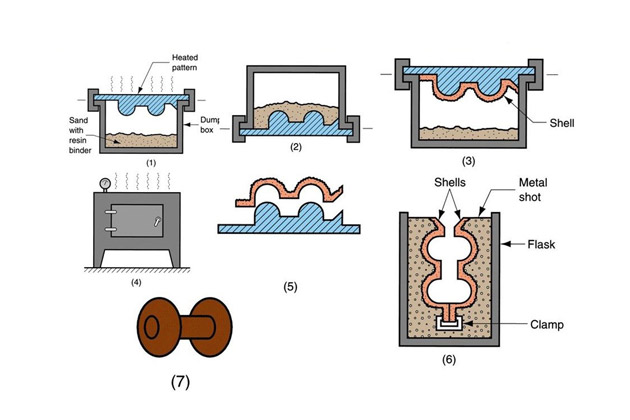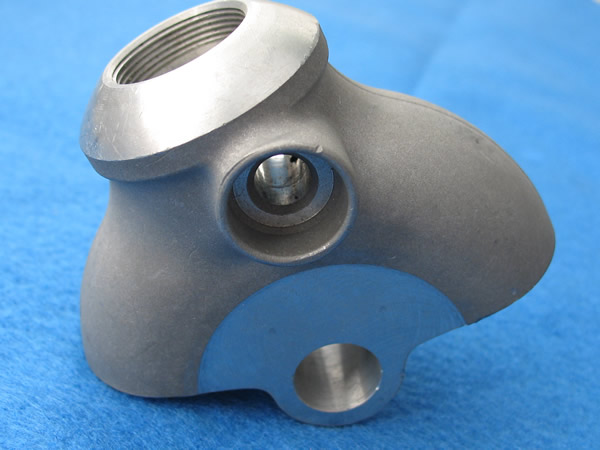Sand casting methods in Aluminum Casting: What’s the difference?
Whatever You Required to Find Out About the Uses and Perks of Aluminum Castings
Aluminum castings play an essential role across different sectors, providing one-of-a-kind properties that boost product performance. Their lightweight nature and toughness make them excellent for applications in automotive and aerospace sectors. Additionally, the versatility of casting approaches permits complex layouts and tight tolerances. As the need for sustainable services increases, comprehending the advantages and applications of aluminum castings ends up being progressively crucial. What specific benefits do they offer over other materials?
Review of Aluminum Casting Processes
Aluminum casting processes encompass a range of techniques used to shape molten aluminum into desired types. These methods consist of sand spreading, die casting, and financial investment spreading, each offering distinct benefits relying on the application (Aluminum Casting). Sand spreading entails creating a mold from sand, permitting elaborate styles and big components, while die casting makes use of high stress to infuse molten aluminum into metal molds, making certain accuracy and smooth finishes. Investment spreading, likewise recognized as lost-wax spreading, produces complex forms with outstanding dimensional accuracy, making it appropriate for in-depth parts
These processes are defined by their ability to produce lightweight, long lasting components that show superb deterioration resistance. The adaptability of aluminum allows for customization in numerous industries, from auto to aerospace. In addition, the ability to reuse aluminum improves the sustainability of these casting processes, decreasing environmental impact while preserving material integrity. Understanding these methods is necessary for enhancing production effectiveness and accomplishing premium aluminum castings.
Trick Applications of Aluminum Castings
Aluminum castings play an important role throughout different sectors, specifically in vehicle, aerospace, and customer electronics. In the vehicle field, they add to light-weight structures that improve gas efficiency. Aerospace components profit from aluminum's strength-to-weight proportion, while consumer electronic devices take advantage of its versatility for effective manufacturing.
Automotive Market Applications
As the auto industry proceeds to progress, manufacturers increasingly rely on aluminum castings for their lightweight yet durable properties. These castings play an essential duty in improving lorry performance, gas effectiveness, and general safety and security. Key applications consist of engine blocks, transmission real estates, and architectural parts, which take advantage of aluminum's superb strength-to-weight proportion. Furthermore, aluminum castings facilitate complicated geometries, enabling for innovative layouts that improve aerodynamics and minimize drag. The corrosion resistance of aluminum likewise adds to longevity, reducing upkeep expenses for both manufacturers and customers. As electrical automobiles gain popularity, aluminum castings are essential for battery units and various other components, additionally strengthening their relevance in the future of automotive manufacturing.
Aerospace Element Production
In the aerospace industry, aluminum castings are indispensable to the manufacturing of lightweight, high-performance elements. These castings are important for making parts such as engine housings, architectural structures, and touchdown equipment components, where weight decrease is essential for gas efficiency and total efficiency. The superb strength-to-weight ratio of aluminum permits the development of complicated geometries that enhance the rules of aerodynamics. In addition, aluminum's resistance to rust adds to the longevity and dependability of aerospace components, ensuring safety in flight operations. The casting process also enables accurate tolerances, which is vital in conference stringent aerospace sector requirements. Overall, aluminum castings play a pivotal duty beforehand aerospace technology while sustaining the industry's promote sustainable methods.
Consumer Electronic Devices Manufacturing
The usage of aluminum castings in consumer electronic devices manufacturing has actually ended up being significantly substantial because of their lightweight and sturdy buildings. Producers leverage these castings to create components for different gadgets, including smart devices, laptops, and pc gaming consoles. Aluminum's exceptional thermal conductivity likewise helps in warmth dissipation, enhancing device performance and longevity. The convenience of aluminum enables for complex styles and complicated geometries, making it possible for sleek and modern-day visual appeals that appeal to customers. Additionally, aluminum castings can be conveniently recycled, straightening with the expanding demand for sustainable manufacturing practices. As modern technology advances, the function of aluminum castings in developing innovative and reliable consumer electronics is expected to broaden, making them a staple in the industry.

Advantages of Making Use Of Aluminum Castings
While different materials are offered for casting, aluminum attracts attention because of its one-of-a-kind combination of lightweight buildings, stamina, and deterioration resistance. The low density of aluminum makes it a suitable choice for applications where weight decrease is vital, such as in the auto and aerospace sectors. Its excellent strength-to-weight proportion permits producers to produce resilient components without including too much weight.
In addition, aluminum castings can be generated with complex layouts and tight resistances, making it possible for complex geometries that are hard to achieve with other products. The versatility of aluminum permits different casting approaches, consisting of sand, pass away, and investment casting, dealing with varied production needs. Aluminum's convenience of machining and ending up boosts its allure, promoting the creation of top quality surface finishes. Generally, the benefits of utilizing aluminum castings contribute to boosted efficiency and effectiveness in many applications across various markets.
Deterioration Resistance in Aluminum Castings

Natural Oxide Layer
An all-natural oxide layer kinds on the surface area of aluminum castings, offering an important obstacle against environmental variables that can bring about deterioration. This slim, protective movie is a result of the aluminum's response with oxygen in the air, properly shielding the underlying metal from wetness, chemicals, and contaminants. Consequently, aluminum castings show impressive corrosion resistance, which boosts their longevity and durability in various applications. The oxide layer is not only beneficial for protection yet additionally adds to aesthetic qualities, as it can develop a matte finish that several sectors find attractive. In addition, this all-natural procedure lessens the demand for extra finishes, making aluminum castings a cost-effective choice for producers looking for trusted, lasting materials.
Alloy Variations Impact
The structure of aluminum alloys substantially affects their great site rust resistance residential properties in castings. Different alloy variations, such as 1xxx, 2xxx, and 6xxx collection, show unique levels of susceptibility to deterioration. 1xxx alloys, mostly composed of pure aluminum, deal outstanding deterioration resistance due to their high purity. In contrast, 2xxx alloys, which have copper, might experience substantial corrosion when exposed to severe environments. 6xxx alloys, including magnesium and silicon, strike a balance in between stamina and resistance. The presence of alloying elements can enhance or diminish protective oxide layers, inevitably affecting durability and performance. Recognizing these variants is vital for selecting the best alloy for specific applications where read here deterioration resistance is critical.
Layout Adaptability and Customization
Although various materials exist for casting applications, aluminum sticks out because of its amazing design versatility and possibility for modification. This versatility enables designers and designers to produce detailed shapes and types that satisfy certain functional requirements. Aluminum Casting. The low density of aluminum enables lightweight styles, which is particularly beneficial in industries such as vehicle and aerospace, where weight reduction is crucial
Aluminum castings can be tailored to numerous specs, consisting of wall density, surface area coating, and dimensional resistances. This versatility not only improves the aesthetic allure but likewise improves the performance of the final item. Additionally, advanced methods such as 3D printing and computer-aided style (CAD) more promote the personalization procedure, allowing fast prototyping and lowering preparations. Subsequently, aluminum castings can efficiently satisfy the varied demands of various markets while offering suppliers the ability to innovate and respond promptly to market needs.
Comparison With Various Other Casting Materials
While different casting products each have their one-of-a-kind advantages, aluminum constantly shows exceptional residential or commercial properties that make it a recommended choice in lots of applications. Compared to iron and steel, aluminum is considerably lighter, which reduces the general weight of finished items, enhancing gas effectiveness in automotive and aerospace markets. Moreover, aluminum provides superb corrosion resistance, calling for much less upkeep in time contrasted to materials like iron, which can rust.
When juxtaposed with plastics, aluminum's stamina and sturdiness go beyond several synthetic alternatives, making it suitable for demanding settings. In addition, aluminum's visit here thermal and electric conductivity is incredibly more than many other metals, making it ideal for applications requiring effective warmth dissipation or electric components.

Future Patterns in Aluminum Casting Technology
Developments in aluminum casting technology are set to redefine its applications across numerous markets. Innovations in automation and robotics are improving production procedures, enhancing effectiveness and precision. The integration of fabricated intelligence and maker learning allows real-time surveillance and predictive maintenance, minimizing downtime and improving quality control.
Moreover, the development of innovative alloys is expanding the efficiency capabilities of aluminum castings, making them suitable for more requiring applications, especially in automobile and aerospace fields. Sustainable methods are likewise obtaining grip, with raised emphasis on recycling aluminum and decreasing carbon impacts during manufacturing.
Additive manufacturing methods, such as 3D printing, are being checked out to develop complicated geometries that standard methods can not achieve, permitting higher style versatility. These patterns suggest a future where aluminum spreading will certainly not just fulfill but exceed sector assumptions, driving advancement and sustainability in manufacturing.
Regularly Asked Inquiries
Just How Are Aluminum Castings Recycled After Usage?
Aluminum castings are commonly gathered, cleaned up, and processed in recycling centers. The product is thawed down, fine-tuned, and after that changed into new items, consequently conserving sources and lowering ecological impact while keeping aluminum's preferable residential or commercial properties.
What Are the Common Costs Related To Aluminum Castings?
The regular costs linked with aluminum castings differ based on variables such as complexity, quantity, and material specs. Generally, rates range from a couple of dollars per pound to considerably greater amounts for elaborate designs and huge quantities.
Just How Do Aluminum Castings Compare in Weight to Steel Castings?
Aluminum castings weigh considerably much less than steel castings, usually around one-third the weight (Aluminum Casting). This reduced mass permits simpler handling, transportation, and application in numerous markets, adding to improved efficiency in style and manufacturing procedures
What Industries Mainly Count on Aluminum Castings?
Various markets significantly depend on aluminum castings, consisting of vehicle, aerospace, electronics, and customer goods. Their lightweight nature, deterioration resistance, and flexibility make them vital for making elements in these fields, enhancing efficiency and performance.
Are There Any Wellness Dangers Connected With Aluminum Casting Processes?
Wellness dangers connected with aluminum casting processes include direct exposure to fumes, dirt, and chemicals, which can lead to breathing problems and skin irritability. Proper security measures and tools are vital to mitigate these potential dangers in the office.